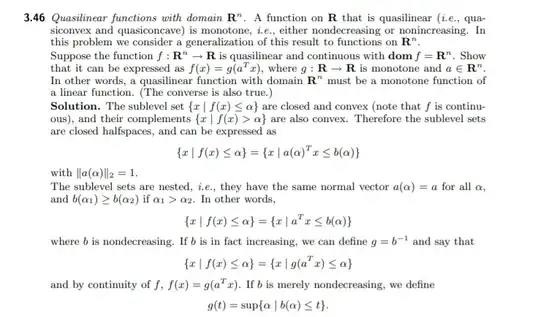Let
$$F \; : \; \mathbb{R}^2 \to \mathbb{R}$$ be a strictly positive function such that $F, \frac{1}{F}$ are both convex. Show that there is a function $$g \; : \; \mathbb{R} \to \mathbb{R}$$ and a vector $$v \in \mathbb{R}^2$$ such that $$F(x) = g(v\cdot x) \;\; \text{ for all } x \in \mathbb{R}^2$$
I have found a solution to this exercise but I'm not satisfied because it uses the extra assumption that $F \in C^2$ and $\nabla F$ is never $\underline{0}$, I would like to find an easier solution that doesn't rely on these extra assumptions.
This is my solution :
I will assume $F \in C^2$ and $\nabla F$ is always non-zero.
First a bit of notation :
I use the euclidean metric on $\mathbb{R}^2$ thus I identify matrices with biliniear forms, if $A$ is a ($2 \times 2$) matrix by $A \geq 0$ I mean
$$(Ax,x) \geq 0 \;\; \forall x \in \mathbb{R}^2$$
by $A \leq B$ I mean $B - A \geq 0$, or equivalently
$$(Ax,x) \leq (Bx,x) \;\; \forall x \in \mathbb{R}^2$$
I claim that
if $A$ is a symmetric matrix and $B$ is any matrix such that $0 \leq A \leq B$
then $\ker(B) \subset \ker(A)$
To show it observe that, since $A$ is symmetric, up to a rotation I can assume it is diagonal,so there are $\lambda,\mu \geq 0$ so that $$ A= \left( {\begin{array}{cc} \lambda & 0 \\ 0 & \mu \\ \end{array} } \right) $$
then if $B v = 0$ and $v = (v_1,v_2)$ I find
$0 \leq \lambda (v_1)^2 + \mu(v_2)^2 \leq 0$
which clearly implies $\lambda v_1 = \mu v_2 = 0$ so $A v = 0$
which shows the claim
Now back to the exercise
I assume $F \in C^2$, thus $1/F \in C^2$ and so convexity implies $\nabla^2 F \geq 0$, $\nabla^2 1/F \geq 0$.
I calculate $\nabla^2 \frac{1}{F}$
\begin{equation}\nabla^2 \frac{1}{F} = \frac{2}{F^3}\nabla F \otimes \nabla F - \frac{1}{F^2}\nabla^2 F \geq 0\end{equation}
from this I easily find
\begin{equation} 0 \leq \nabla^2 F \leq \frac{2}{F} (\nabla F \otimes \nabla F) \end{equation}
so using the previous claim $\ker(\nabla F \otimes \nabla F) \subset \ker(\nabla^2 F)$
but clearly $\ker(\nabla F) \subset \ker(\nabla F \otimes \nabla F)$.
Now let $$\mathcal{N}(x,y,\underline{v}) = \left( {\begin{array}{cc} \nabla F(x,y)\cdot \underline{v} \\ \underline{v} \cdot \underline{v} - 1 \\ \end{array} } \right) $$
I want to use implicit differentiation theorem to find $v = v(x,y)$, so I differentiate $\mathcal{N}$ with respect to $v$
$$\nabla_{\underline{v}}{\mathcal{N}} = \left( {\begin{array}{cc} \nabla F(x,y) \\ 2\underline{v} \\ \end{array} } \right) $$
by definition if $\mathcal{N}(x,y,\underline{v}) = 0$ then the two vectors are orthogonal and they are both non-zero thus $\nabla_{\underline{v}}{\mathcal{N}}$ is invertible and
$$\nabla_{x,y}{\underline{v}} = (\nabla_{\underline{v}}{\mathcal{N}})^{-1}( \nabla_{x,y}{\mathcal{N}})$$
but I have that
$$\nabla_{x,y}{\mathcal{N}} = \left( {\begin{array}{cc} \nabla^2F(x,y) \cdot v \\ \underline{0} \\ \end{array} } \right) = \left( {\begin{array}{cc} \underline{0} \\ \underline{0} \\ \end{array} } \right) $$ and here I'm using $\underline{v} \in \ker{\nabla F} \subset \ker{\nabla^2 F}$
thus $\nabla_{x,y}{\underline{v}} = 0$.
Now fix $\underline{w}$ so that it has norm $1$ and $\nabla F(0,0) \cdot \underline{w} = 0$, Let $U := \{ (x,y) \in \mathbb{R}^2 \; : \; \mathcal{N}(x,y,w) = 0\}$.\
The set is nonempty since $(0,0) \in U$, and by what we have shown the set is open, therefore it's $U =\mathbb{R}^2$, but this shows that $\nabla F(x,y) \cdot w = 0$ for all $(x,y)$ and this concludes the proof.
